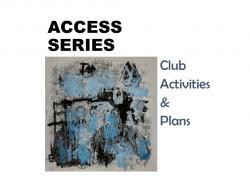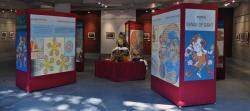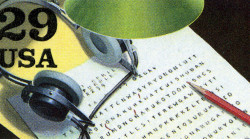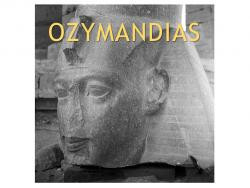Tracie Spinale
Learning Programs Manager
Smithsonian Institution
Middle School (13 to 15 years old), High School (16 to 18 years old), Post-Secondary
Teacher/Educator, Curriculum Coordinator, Parent, Museum Staff
Language Arts And English, Science, Social Studies, Arts, Special Education, Career and Tech Ed, Other
: Museum Studies
Hi there! I am the Learning Programs Manager at the Office of the Under Secretary for Education (OUSE) where I focus on positive youth development programs.
Enjoy!
- Positive Youth Development
- 4-H & 4-H Guide to the Smithsonian booklet
- Boys & Girls Clubs of America
- All Access Digital Arts Program - Collections for teens and youth with cognitive differences
- Distance Learning Resources
- A cultural science series from the Smithsonian Arctic Studies Center in Alaska (#arcticstudies)
- Maker and activity collections about environmental and social justice issues
- Topical collections
- A series on the intersection of Buddhism and Western Science
Tracie Spinale's collections
Lesson Plans - All Access Digital Arts Club: Activities + Plans for Neurodiverse Teens
<p>The Smithsonian Office of Educational Technology's All Access Digital Arts Program (2012-2016) provided skill-building opportunities in digital arts and communications, creative expression, and social inclusion to a spectrum of teen learners in the Washington, DC metro area. Participating youth visited Smithsonian science, history, and art museums, created digital and physical artworks based upon a tailored curriculum, engaged in social interactions online and in-person, gained digital literacy skills, and developed friendships with other teens.
Through once-per-month club outreach activities and summer intensive camps and workshops, students were exposed to communication, collaborative learning, research, and problem solving. The program served up to 20 youth per session, ages 14 through 22 with cognitive and intellectual disabilities. The youth experienced skill building, leadership opportunities, and social integration through Smithsonian resources, socialization opportunities, and computer skills. Youth participated in 1.) One- and two-week multi-media digital arts workshops whose outcome was student-produced artworks, songs, and movies that were shared with family and friends at openings and online via a social network; and 2.) Club activities--to build upon skills developed during the summer, and maintain social connections. </p>
<p>All Access Club activities were offered to alumni of the summer workshops, and were held once monthly on Saturdays during the year to build upon skills developed during the workshop, and maintain social connections. During the club, teens practiced social skills through guided activities and Smithsonian museum visits, and produced original digital and hands-on art projects at the Hirshhorn ARTLAB+. Educators led the group in a series of planned educational activities related to the day’s theme—such as “the universe” or “oceans”. Volunteers assisted club members to use social media, tablets, cameras and laptops to facilitate the digital experience. The activities and resources promoted digital literacy skills, and can motivate families to visit museums to learn, and for teens to build self-esteem. An evaluation session on the final day allowed teens to express their thoughts to the club organizers.</p>
<p>Special thanks to colleague Joshua P. Taylor, M.Ed., VCU Autism Center for Excellence, Virginia Commonwealth University</p>
<p>Keywords: access, disability, accessibility, neurodiversity, special education, SPED, out of school learning, informal learning, cognitive, social skills, engagement, passion, creativity, empowerment, self-determination, teens in museums, teens, teenagers, after school, out of school learning, informal learning<br></p>
 Tracie Spinale
Tracie Spinale
19
"The World of Your Senses": Parallel Perspectives from Tibetan Buddhism and Western Science on Sensory Perception
<p>"The World of Your Senses" shares parallel perspectives from Tibetan Buddhism and western science on sensory perception. This collection explores the questions: How do we see? How does hearing work? How do we perceive smell? How does taste function? How do we sense touch? In addition, the Buddhist perspective includes a sixth sense... mind consciousness!</p>
<p>"The World of Your Senses" is the result of many years of work growing out of directives from His Holiness the Dalai Lama and his long history engaging Western scientists in dialogue. The script, content, and imagery were envisioned by a dedicated and curiosity-filled group of thirty Tibetan Buddhist monastics-in-exile from monasteries and nunneries in India, through the "Science for Monks and Nuns" program. The creation of the physical exhibit, launched in 2010, was supported through a unique collaboration between the Library of Tibetan Works and Archives (LWTA in Dharamsala, India), the Sager Family Foundation, the Smithsonian Institution in Washington, D.C. (SCEMS/SCLDA/OET & OEC/Smithsonian Exhibitions), and the Exploratorium in San Francisco. It has since traveled to the United States, Nepal, and Bhutan.</p>
<p>The resource is bi-lingual: English and Tibetan.</p>
<p>RELATED COLLECTIONS:</p>
<p>Senses Series – <strong><a href="http://learninglab.si.edu/q/ll-c/n2f39XxkfBRJeHPk" target="_blank">Sight in Humans and Animals</a></strong> (<a href="http://learninglab.si.edu/q/ll-c/n2f39XxkfBRJeHPk">http://learninglab.si.edu/q/ll-c/n2f39XxkfBRJeHPk</a>)<br><br>Senses Series – <strong><a href="http://learninglab.si.edu/q/ll-c/7EbVTM49NgWiGrzA" target="_blank">Hearing</a></strong> (<a href="http://learninglab.si.edu/q/ll-c/7EbVTM49NgWiGrzA">http://learninglab.si.edu/q/ll-c/7EbVTM49NgWiGrzA</a>)<br><br>Senses Series – <strong><a href="http://learninglab.si.edu/q/ll-c/7LjjBHybUk9HE8Wj" target="_blank">Smell</a> </strong>(<a href="http://learninglab.si.edu/q/ll-c/7LjjBHybUk9HE8Wj">http://learninglab.si.edu/q/ll-c/7LjjBHybUk9HE8Wj</a>)<br><br>Senses Series – <strong><a href="http://learninglab.si.edu/q/ll-c/2w7r7PVoAgghiYmL" target="_blank">Taste</a> </strong> (<a href="http://learninglab.si.edu/q/ll-c/2w7r7PVoAgghiYmL" style="background-color:rgb(63,63,63);">http://learninglab.si.edu/q/ll-c/2w7r7PVoAgghiYmL</a>)<br><br>Senses Series – <strong><a href="http://learninglab.si.edu/q/ll-c/oon5rHojeyrEwNEE" target="_blank">Touch</a> </strong>(<a href="http://learninglab.si.edu/q/ll-c/oon5rHojeyrEwNEE" style="background-color:rgb(63,63,63);">http://learninglab.si.edu/q/ll-c/oon5rHojeyrEwNEE</a>)</p>
<p><br>This collection is based Science For Monks, <a href="http://scienceformonks.org/world-of-your-senses-web-tour/" target="_blank">World of Your Senses</a> (2010).</p>
 Tracie Spinale
Tracie Spinale
28
Color Series - Green
<p>This topical collection of the color green is part of a color series and was originally used in a collage art activity (printed out; using paper, glue, and art materials) with a group of teens with cognitive disabilities during a summer camp program. I was inspired to create the series after a few of our students mentioned their passionate interest in specific colors, and how they thought in colors.</p>
<p>Tags: color series, decision-making, self-determination, student empowerment, disability, All Access Digital Arts Program</p>
 Tracie Spinale
Tracie Spinale
30
Color Series: Yellow
<p>This topical collection of the color yellow is part of a color series and was originally used in a collage art activity (printed out; using paper, glue, and art materials) with a group of teens with cognitive disabilities during a summer camp program. I was inspired to create the series after a few of our students mentioned their passionate interest in specific colors, and how they thought in colors<br></p>
<p>Tags: color series, decision-making, self-determination, student empowerment, disability, All Access Digital Arts Program</p>
 Tracie Spinale
Tracie Spinale
30
Color Series: Pink
<p>This topical collection of the color pink is part of a color series and was originally used in a collage art activity (printed out; using paper, glue, and art materials) with a group of teens with cognitive disabilities during a summer camp program. </p>
<p>Tags: color series, decision-making, self-determination, student empowerment, disability, All Access Digital Arts Program</p>
 Tracie Spinale
Tracie Spinale
30
SENSES SERIES
<p>Aggregate of Learning Lab collections about the Smithsonian collaboration with the Science for Monks and Nuns Program - senses and sensory perception.<br /></p>
 Tracie Spinale
Tracie Spinale
11
Ciphers and Codes
<p>Throughout history, ciphers and secret codes were devised to keep intelligence from falling into the wrong hands. From the WWII German "Enigma" machine, to America's Cherokee Code Talkers, people used ciphers and codes to safeguard secrets. One of my favorite mysterious artworks is the sculpture <em>Antipodes,</em> outside of the Hirshhorn Museum. No one knows what it means, and its companion piece <em>Kryptos</em> is at Langley. Use this collection an inspiration piece for puzzle lovers and mystery solvers both young and old. There are many free sites on the web that you can use to create your own coded messages like, "Jsotd ymj Qjfwsnsl Qfg!" (Hint: Caesarian Shift).</p>
 Tracie Spinale
Tracie Spinale
25
Color Series - Purple
<p>This topical collection of the color purple is part of a color series and was originally used in a collage art activity (printed out; using paper, glue, and art materials) with a group of teens with cognitive disabilities during a summer camp program. I was inspired to create the series after a few of our students mentioned their passionate interest in specific colors, and how they thought in colors.</p>
<p>Tags: color series, decision-making, self-determination, student empowerment, disability, All Access Digital Arts Program</p>
 Tracie Spinale
Tracie Spinale
30
Access Series: Animals - Domestic and Wild!
<p>This topical collection of artworks is all about animals—domestic pets, and wild, untamed beasts. Horses, elephants, dinosaurs, zebras, pandas...cats, hogs, frogs, dogs, lions, tigers, and bears; fish and fowl, monkeys that howl - you'll find all of them here. This collections was originally used in a collage art activity (printed out; using paper, glue, and art materials), and as a discussion prompt in an informal learning activity with a group of teens with cognitive disabilities during a summer camp program. <br><br>Other suggested uses beyond collage and discussion prompts would be a writing exercise, "Which animals have you seen before and where did you see them? If you could have any one of these animals as a pet, which would you choose and why?" Use the visible thinking routine, "See|Think|Wonder" as a starting point for the writing prompt, and the images for inspiration. Also included is a lesson plan which could be adapted for a visit to a natural history museum or zoo.</p>
<p><br> Tags: Decision Making, Disabilities, Self-Determination, Self-Efficacy, Student Empowerment, All Access Digital Arts Program, teens in museums, teens, teenagers, after school, out of school learning, informal learning</p>
 Tracie Spinale
Tracie Spinale
215
Access Series: Fantastic Creatures
<p>This topical collection of artworks is based upon "fantastical creatures." It was originally used in a collage art activity (printed out; using paper, glue, and art materials); and as a discussion prompt in an informal learning activity with a group of teens with cognitive disabilities during a summer camp program. <br></p>
<p>Other suggested uses beyond collage and discussion prompts would be a writing exercise, utilizing the "See|Think|Wonder" visible thinking routine or the “Conversing with an Object” discussion prompt as writing inspiration. You could also pair the collection with popular young adult fantasy novels, and ancient myths and legends. Or draw your own fantastic creature.<br><br> Descriptors: Decision Making, Disabilities, Self-Determination, Self-Efficacy, Student Empowerment, All Access Digital Arts Program, teens in museums, teens, teenagers, after school, out of school learning, informal learning</p>
 Tracie Spinale
Tracie Spinale
41
Access Series: People, Friends, and Family--Together and Alone
<p>This topical collection of people—together in groups with friends or families (mother, father, sister, brother, aunt, uncle, cousin, grandmother, and grandfather); different genders, ages, and ethnicities, and "selfies"—was originally used in a collage art activity (printed out; using paper, glue, and art materials); and as a discussion prompt in an informal learning activity with a group of teens with cognitive disabilities during a summer camp program. Use the visible thinking routine, "See|Think|Wonder" and Conversing with Objects discussion prompt as a starting point for the writing prompt, and the images for inspiration. </p>
<p>Tags: decision-making, self-determination, student empowerment, disability, All Access Digital Arts Program, teens in museums, teens, teenagers, after school, out of school learning, informal learning</p>
 Tracie Spinale
Tracie Spinale
118
Shelley's "Ozymandias" Poem: Museum Objects and Inspired Art
<p>How have museum objects and antiquities inspired arts and literature? Read and listen to a famous poem written two hundred years ago by English author Percy Bysshe Shelley, "Ozymandias." Then, view artworks which in turn were inspired by the poem. View the environmental landscapes and settings in ancient Egypt which inspired the original poem about the colossal sculpture of a famous ruler from over three thousand years ago. The collection concludes with a link to view a draft of the poem. Will Shelley's work inspire the creation of your own poem or artwork about a place you've traveled, or an object you've seen in a museum?</p>
<p>For a hand's-on paper-craft activity for younger students, visit <a href="https://learninglab.si.edu/q/ll-c/8MmERhz4keCesAxN"><strong>Nile, Nile Crocodile</strong></a> collection</p>
<p>keywords: sonnet, Ancient Egypt, Rameses II, Thebes, impermanence, cultural patrimony, distance learning, poetry, object-based learning</p>
 Tracie Spinale
Tracie Spinale
23
























